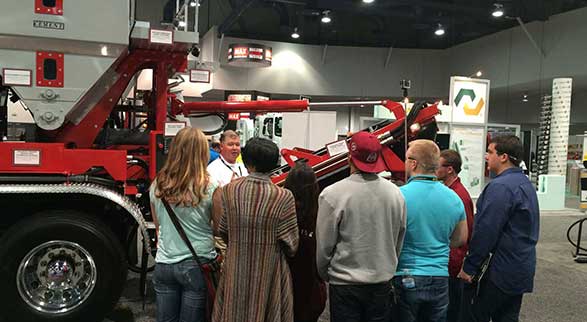A
Admix Flow Valve: The admix control valves are manually operated and located close to the admix flowmeters in the control panel. They provide a means for controlling the flow rate of admixture in to the concrete in ounces or quarters per minute or gallons per hour. Also ml or liters.
Admix Tanks: UV resistant poly tanks mounted to the side of the unit which provides carrying capacity for liquid admixtures.
Aerator Pad: Installed inside the cement bin, the aerator pads help promote consistent flow of cement. They’re particularly helpful after the mixer has driven to a job site where the cement can become compacted.
B
Belt Wiper: A solid rubber strip mounted between two steel plates. The strip is on the bottom side of the conveyor belt before the point where materials fall into the mixer. Its function is to scrape material from the conveyor belt.
Bin Seals (Front Bin Seals): A pair of rubber flaps, mounted at the front of the sand bin and at the front of the stone bin, which rides on the conveyor belt. These flaps prevent sand and coarse aggregate from leaking from the front of the bin.
C
Cement Bin: Weather tight hopper that holds dry cement powder. It has a rectangular loading hatch and a bag breaking grate. An optional pneumatic fill system is available.
Cement Bin Lower Auger (Metering Auger): Lower auger inside the cement bin and is partly encased inside a steel pipe. It consistently and accurately meters the cement into the transfer auger.
Cement Bin Top Auger: Upper most auger contained inside the cement bin. This auger forces the cement to the outside of the cement bin where it’s picked up by the metering auger.
Cement Feeder Clutch: The dog or pin type clutch enables the cement feeder to disengage from its drive. This lets the conveyor belt to operate without discharging cement from the cement bin. The clutch disengages during aggregate calibration and also when necessary to empty aggregate from the aggregate bin.
Cement Transfer Auger: This auger deposits the metered cement into the mixer throat.
Chutes (Extension Chutes): All concrete mobile units have at least two and up to three chutes attached to the discharge end of the mixer assembly.
Conveyor Belt Assembly: The conveyor belt assembly consists of two parallel roller chains with one-inch angle iron cross bars welded between their side plates. A two-ply rubber covering bolts to these cross bars to complete the assembly.
Conveyor Chain Oiler: The conveyor chain oiler consists of a reservoir, valves, hoses and the dripper assembly. It provides oil to the conveyor chain and the conveyor rail. It operates automatically only when the conveyor belt is running.
Count (Meter Reading): The number shown on the digital register when concrete production stops or the number shown on the counter for a specific amount of material. This is the number used to determine the amount of concrete produced.
D
Dial Plate (Dial Face): A circular, indexed plate which allows the bin gates to be set at a specific opening.
Drain Cock: Drain cocks are located at all low points in the water and admix systems (the water pump, water strainer, and various points in the water lines). These allow the system to drain and blow out when the ambient temperature is below freezing.
Dry Color System: Water tight steel hopper which holds the dry pigment used in the manufacture of color concrete. The dry pigment discharges through the auger and has a reverse mechanism for cleanout.
F
Flighting: The flighting is welded to the auger shaft and provides most of the conveying action for the mixer system.
I
Inclinometer: The inclinometer determines and displays the mixer angle when in operating position.


